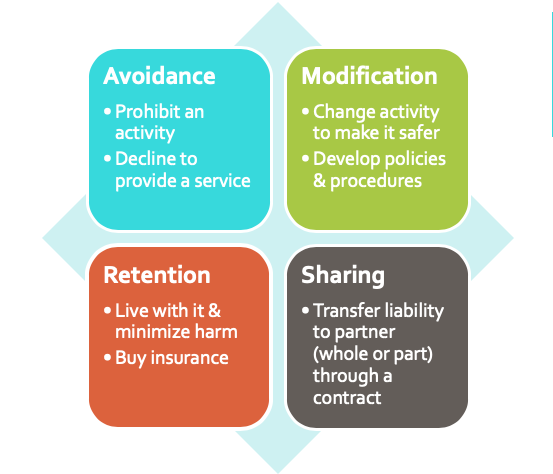 COVID-19 & Volunteer Organizations: Business Continuity & Recovery Planning
COVID-19 & Volunteer Organizations: Business Continuity & Recovery Planning
In our VolunteerPro Membership Community, there’s been plenty of conversation about COVID-19 and volunteer organizations.
Should volunteers be included in the response effort in organizations that can’t shut down due to the nature of their essential services? How can volunteers be protected? How can volunteers continue to be engaged, if they participate in person? What impact will the pandemic have on future volunteering levels?
There aren’t a lot of answers right now.
But that doesn’t mean organizations can’t set a plan in place for current business continuity and a proactive plan for when the danger passes.
I’ve written recently about how to develop nonprofit emergency plans, and some of those tips apply here.
Given the unique, and evolving, situation we currently find ourselves faced with, we’re adding additional information here.
Risk Assessments & Planning for Nonprofits
A fundamental risk management process can be helpful in thinking through how the COVID-19 epidemic might impact volunteer organizations.
There are five basic types of risk organizations might consider. They are risks to:
- People – possible harm to volunteers, employees, clients, customers, partners, stakeholders, and any others
- Property – possible damage to facilities, equipment, tools, etc.
- Reputation – possible impact on your agency’s standing or respect from the community, volunteers, stakeholders, etc.
- Income – possible impact on current and future revenue, grants, or donations
- Liability – possible legal implications for neglect of duty of care
By brainstorming a list of possible risks in these five categories, you can begin to develop a broad list of potential risks related to the Coronavirus and ensure you cover your bases.
Then, you can begin to assess whether or not issues need attention right now and what you might want to include in your plan going forward.
To filter your brainstormed list into what needs attention right now, rate each for 1) the likelihood of occurrence and 2) magnitude of harm for each as low, medium, or high. Those that rate high for both are the most urgent to address right away. Those that rate medium and/or high should be tackled next.
Once you identify and prioritize risks, you can choose specific techniques for managing them. There are four common ways to do so – Avoidance, Modification, Retention, and Sharing. While not all make sense in the current context, they may give you ideas on how to proceed.
4 Risk Management Techniques

COVID-19 Volunteer Organizations Business Continuity & Recovery Planning
You should put together a Business Continuity Plan to ensure that time-sensitive and critical organization processes can continue, or be resumed quickly, once danger has passed.
There are several topic areas that should be included in your plan.
Communications
As a leader in your community, your nonprofit has the opportunity to lead by example. As a volunteer organization with expertise in the mobilization of people, you can both facilitate community support strategies and help amplify the message that by following local quarantine and isolation guidelines we are supporting our neighbors and the health of our communities.
Consistent communications to all stakeholders, both internal and external, will be vital to maintaining calm and promoting community solidarity through the crisis.
Make sure you have an updated emergency contact list of all key stakeholders. Confirm each contact’s preferred level of privacy and to whom you can share their contact information (e.g., for phone trees or peer-to-peer support calls).
Nonprofit HR has created a Coronavirus Digital Information Portal with helpful information and templates. They will also be hosting online webinars for Information in this rapidly-evolving context.
Also, below are several resources that offer fact-based information for your communications efforts and can be credible sites to reference to inform others.
Helpful COVID-19 Resources
- Preventing COVID-19 Spread in Communities — https://www.cdc.gov/coronavirus/2019-ncov/community
- Local Health Departments (USA) — https://www.naccho.org/membership/lhd-directory
- State Health Departments (USA) — https://www.cdc.gov/publichealthgateway/healthdirectories/healthdepartments.html
- World Health Organization – https://www.who.int/emergencies/diseases/novel-coronavirus-2019
- Global Map on COVID-10 Spread — https://www.nytimes.com/interactive/2020/world/coronavirus-maps.html
- Updates on Global Cases — https://www.who.int/emergencies/diseases/novel-coronavirus-2019
In order to evolve, form an agency wide COVID-19 Response Team and make sure that volunteer services are represented. Meet regularly as the pandemic evolves (see the COVID-19 resources listed above for more detailed information as it evolves).
Also, appoint a spokesperson for your agency and develop talking points that address:
- Your leadership in the community
- Speak of social distancing norms as an act of community solidarity
- How you are supporting the most vulnerable of those you serve
- Where and when you will be communicating updates to the public
This will help maintain the public’s trust in your organization as a community leader.
For communications directed specifically toward volunteers, consider how you can continue to keep them up to date on your operations.
How can you facilitate regular online communications AND two-way conversations? How can you reach those who don’t use computers (e.g. via phone trees)?
Also, how can your leadership “show up” for volunteers, showing empathy and thanking them for their commitments — past, current, and future — to service?
Also, refer to our VolunteerPro guide on managing volunteers during the Coronavirus for more suggestions for the role of leaders.
Health and Safety Guidelines

Don’t rely on volunteers and employees to guess what actions are appropriate to take at which step.
Frequent handwashing, social distance, quarantine, and isolation are recommendations that are shared publicly, but what do they mean exactly in your organizational context?
The U.S. Occupational Safety and Health Administration (OSHA) has extensive information for workplace protection specifically related to COVID-19 as an infectious disease.
OSHA’s General Duty Clause requires employers to furnish to each worker “employment and a place of employment, which are free from recognized hazards that are causing or are likely to cause death or serious physical harm.” Assume this clause applies to unpaid volunteers, as well.
If your organization is not a medical facility, health and safety may have taken a back seat at your organization. Now is a great time to refresh your knowledge.
Also, make sure you have information about your state’s health and safety requirements, if they exist.
COVID-19 Volunteer Scenarios and Contingency Plans
It also helps to detail out scenarios for partial and full shutdowns. If you can map out If-Then circumstances and how your agency plans to react, you’ll be better prepared with the time comes to take action.
Discuss what will trigger each course of action. If it makes sense, create flow charts to communicate complex scenarios.
There are also specific questions you might want to ask regarding volunteer involvement.
Consider how you will operate in the absence of volunteers by 10%, 25%, 50%, 75%, 100%? What services would you keep or curtail if significant volunteer attrition were to occur?
Create a matrix of the mission-critical services for your organization and the minimum support needed for each. If volunteers were not, or could not, be available which services would be suspended?
If critical volunteers were to continue to assist on-site, what special tools and equipment would be required? What steps would you need to take to keep them active, if it were safe and appropriate?
Check with your agency’s legal team to determine what legal issues might flow if volunteers risk exposure through their service.
Remote Work

When planning for employees to work from home, note that volunteers can, too. If provided the appropriate tools, clearly-defined assignments, and a person or place to go for support, they can be very productive.
Both in our VolunteerPro Membership Community and Insider Group on Facebook, leaders of volunteers have been sharing ideas for mission-driven volunteer projects. Here are a few:
- Collect volunteer success stories and favorite volunteer memories to be shared later in marketing, new volunteer training, etc.
- Invite volunteers to take part in program planning and evaluation virtually to set the stage for future success.
- Ask volunteers to write notes and make cards to long-term care residents or hospital patients.
- Ask existing volunteers, or recruit new volunteers via Catchafire, with expertise to help draft response plans, flexible work policies, implement and train on the use of remote tech tools, etc.
- Form a team to review volunteer policies and update the volunteer handbook.
- Set up virtual mentoring or storytelling hours where volunteers can reach children stuck at home.
- Have volunteers assemble info kits, training packets, mailings, student packets, or any other administrative assembly work that they can pick up and drop off.
- Have a small group of volunteers help with database clean up and ask them to conduct some data analysis on current volunteer engagement trends.
- Have interns conduct phone interviews with those served by your organization to improve marketing and communications.
- Have volunteers call and check on fellow volunteers a certain number of times per week.
- Form a communications team to write a series of newsletter articles or blog posts, and to create social media graphics that can be seeded out for the remainder of the year.
- Ask a small team to update your directory of community resources.
- Form a team to revamp your volunteer training program or lead an online volunteer in-service training series.
These are only a few of the many way’s volunteers can remain engaged. Look through your to-do list. Is there anything that a volunteer might enjoy assisting with in their downtime? Is there anything volunteer leaders can help prepare for when you re-open your doors?
Also, if you can’t utilize volunteer support during a shutdown, due to the nature of your work, recommend they help other organizations and provide links to opportunities to assist.
Also, TechSoup has posted Nonprofit Resources for Remote Work During the COVID-19 Outbreak here.
Volunteer Services Program Recovery
Finally, start planning now for how you will make up for potential volunteer attrition. What plans will you have in place to recruit volunteers to replace those who may not return.
For ideas, check out our Free [eCourse] Better Volunteer Recruitment in 6 Easy Steps to jump start your planning.
Also, throughout the crisis, keep track of issues and challenges that crop up using a shared spreadsheet. After the pandemic passes, you can review and fix any issues and add them to a revised Business Continuity and Recovery Plan.
For more specifics on building a plan, the Alliance for Human Services has created a Continuity of Operation Plan (COOP) for Nonprofit Human Services Providers template that is particularly helpful when thinking through what should be included in your agency’s response plan.
Also, check out Ready.gov’s Business Continuity Plan planning process.
You’ve Got This!
Volunteers can be wonderful ambassadors in helping share messages about your organization and how it is responding proactively to the crisis. They can also be a source of support for one another and those you serve.
It will be important for you to stay connected, or you risk losing some of these valued supporters after the pandemic has passed. So, stay in the game.
Your community is strong, and you can get through this.






